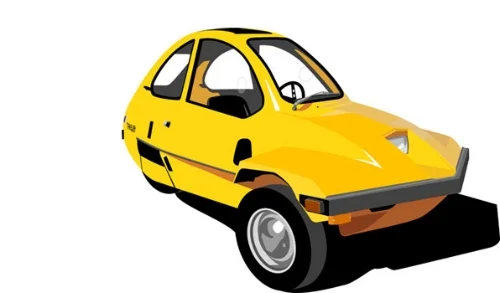The FreeWay
There is nothing like an Energy Crisis to arouse America’s entrepreneurial spirit. The OPEC oil embargo of 1973, along with the high gas prices and long fueling lines that followed, spawned some economical but odd but little cars. There was the virtuous CitiCar that was powered by electricity, and the dubious Dale that apparently ran on bullshit. Six years later came the Iranian Revolution, more shortages, and fuel prices that again soared. This time, the pint-sized solution to the nation’s gaseous woes would be the HMV FreeWay.
The Free Way (www.boogerballs.com)
The FreeWay was made by High Mileage Vehicles, Inc. of Barnsville, MN, the brainchild of an engineer named Dave Edmonson. With the FreeWay, Edmondson would take basic transportation to the extremes of basic. It had 1 door, 1 seat, 1 headlight and a 1-cylinder engine. This fiberglass-bodied, 700lb helmet-shaped minicar looked less like a car and more like an enclosed motorcycle. In fact, one of HMV’s sales pitches was that the FreeWay could be registered as a motorcycle. But you didn’t need a helmet - presumably because you were driving one.
The FreeWay’s chassis actually shares much of its DNA a snowmobile. Being a product of Minnesota, this certainly makes sense. That rear-mounted Tecumseh-sourced engine and CVT transmission would have seen far more action barreling though the snows of the upper Midwest, than on the freeway in a FreeWay.
1980 HMV Freeway (www.BringaTrailor.com)
Edmonson claimed the FreeWay got 84mpg from its standard 12hp gasoline engine – more than 5 times the mileage of a typical American car. A “sport” model put out 16hp. This more powerful FreeWay could probably reach its top speed of 60mph faster than a Chevy Chevette. But that added muscle would cost you. This FreeWay for the fast lane only got 60mpg.
HMV also listed in their catalogues both an electric and a diesel version. But the former had very limited range, and the latter was prohibitively expensive. Both sold in extremely limited - if any - numbers.
By the early 1980s, oil markets had returned to equilibrium. Fuel prices plunged, and so did HMV’s sales. The company went belly-up in 1982, after selling about 700 FreeWays over 3 years. Every so often, one shows up on eBay, BarnFinds, or some website delighting in automotive oddities, thus adding a few smiles to the collective face of humanity.
FreeWay-ers sharing the joy (www.Wikipedia.com)
As part of HMV’s bankruptcy proceedings, D&A Vehicles, also of Minnesota, acquired the rights to the car. They turned it into a 2-seat roadster, which they thought would be more saleable, and called it the Minikin. But instead of smiles, the Minikin evoked puzzlement. Only a handful were sold before D&A also called it quits.
1983 Minikin (www.3Wheelers.com)
Dave Edmonson was certainly not the first entrepreneur to convince himself that the journey to automotive greatness left three tracks. The history of 3-wheeled cars is as long as the history of the car itself. The 1886 Benz, recognized by most as the first automobile, had a wheel count of three. It is not surprising then that the FreeWay wouldn’t be the last. In 2009, Paul Elio of Phoenix, AZ announced his own eponymously named 3-wheeler that would debut in 2012. What was it about 84mpg? Like the FreeWay a generation earlier, the Elio also claimed that magical mileage number. Due to funding challenges, the Elio’s launch date was eventually pushed back to 2014, then 2016, 2018, and lately 2019.
The Elio (www.ElioMotors.com)
Hmm, maybe the FreeWay will be America’s last fuel efficent 3-wheeler.
Copyright@2019 by Mal Pearson
Sources:
3wheelers.com A source of delight for car enthusiasts of the three wheeled variety
Barnfinds.com Where I came across a FreeWay for the first time







